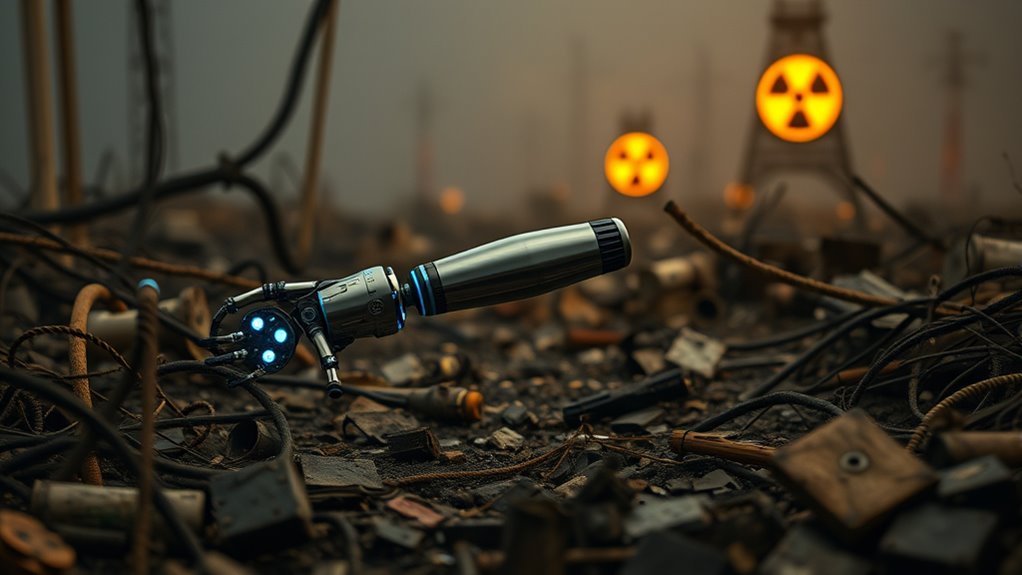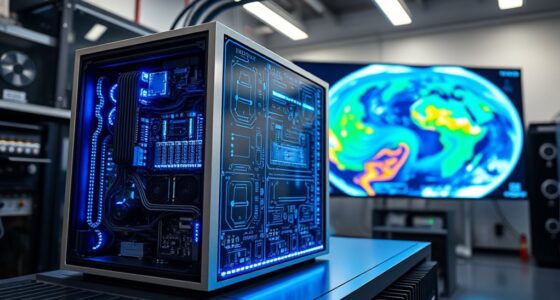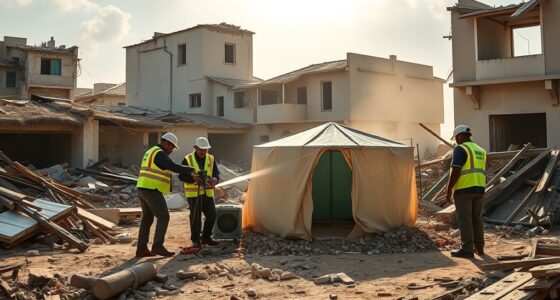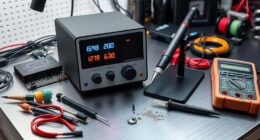Robotics play a vital role in nuclear disaster management by allowing you to perform inspections, collect samples, and contain hazards in areas with dangerously high radiation levels. These robots are designed with specialized shielding to protect sensitive parts and can be operated remotely, keeping you safe from radiation exposure. Advanced features like autonomous navigation and real-time sensors enhance their effectiveness for critical tasks. If you want to understand how these technologies are transforming disaster response, there’s more to explore.
Key Takeaways
- Robots perform hazardous environment inspections, sample collection, and containment to protect human responders during nuclear disasters.
- Radiation shielding in robots ensures durability and reliable operation in high-radiation zones.
- Remote operation systems allow safe control of robots via real-time video, sensors, and feedback, minimizing human exposure.
- Integration of shielding and remote control enhances access, data collection, and repair capabilities in extreme radiation areas.
- Autonomous technologies and advanced sensors improve responsiveness, navigation, and adaptability in nuclear emergency management.

Robotics have become indispensable tools in managing nuclear disasters, where human access is often too dangerous or impossible. When radiation levels soar and conditions are lethal, robots step in to perform tasks that would otherwise threaten human lives. One of the key roles these machines play involves radiation shielding, which is essential in protecting sensitive electronics and robotic components from intense radiation exposure. By incorporating specialized materials and shielding techniques, engineers design robots that can withstand hazardous environments for extended periods. This guarantees that they can operate reliably in the high-radiation zones, providing critical data and performing vital tasks without succumbing to radiation damage.
Robots with radiation shielding ensure safe, reliable operation in hazardous nuclear environments.
Remote operation is another cornerstone of robotics in nuclear disaster management. Because direct human intervention is often impossible, you rely on sophisticated remote control systems to maneuver robots safely through contaminated areas. These systems enable operators to control the robots from a safe distance, often using real-time video feeds, haptic feedback, and advanced sensors. The remote operation capability allows you to perform inspections, collect samples, and even dismantle or contain damaged reactors without exposing personnel to danger. This setup not only minimizes risk but also enhances precision, as operators can make adjustments based on live data and environmental feedback, improving overall safety and efficiency.
The integration of radiation shielding with remote operation technology creates a powerful synergy. Robots equipped with effective shielding can venture into zones with extreme radiation levels, gathering data or performing repairs that would be unthinkable for humans. Meanwhile, remote operation systems ensure that you retain full control, even in unpredictable or hazardous conditions. As a result, you can extend the reach of disaster response efforts, accessing areas previously deemed unreachable due to radiation risks. This combination reduces response times, enhances safety protocols, and increases the likelihood of successful containment and cleanup efforts.
Moreover, advancements in robotics now include autonomous features, allowing these machines to perform certain tasks independently, reducing the burden on human operators. Sophisticated algorithms enable robots to navigate complex environments, avoid obstacles, and even identify areas requiring urgent attention. Still, remote operation remains indispensable in situations where human judgment and adaptability are essential. These technological innovations are supported by ongoing improvements in sensor technology, which provide robots with better environmental awareness and data accuracy. Together, these technologies create a resilient framework for managing nuclear emergencies more effectively and safely. In essence, you are leveraging robotics with radiation shielding and remote operation to turn hazardous zones into manageable environments, ultimately saving lives and minimizing environmental impact.
Frequently Asked Questions
How Do Robots Handle Radioactive Contamination Over Time?
You rely on robots equipped with robotic decontamination tools to handle radioactive contamination over time. They use specialized radiation shielding to protect themselves and their surroundings while cleaning or inspecting affected areas. These robots can operate for extended periods, performing tasks like removing contaminated debris or applying decontamination agents, all while minimizing human exposure. Their durability and advanced shielding guarantee they continue functioning effectively in the harsh, radioactive environment.
What Are the Limitations of Robots in Extreme Radiation Zones?
You should know that robots struggle in extreme radiation zones, with studies showing they often operate for just hours before failure. Radiation shielding is essential but limited, as it adds weight and reduces mobility. Additionally, mobility constraints hinder their ability to navigate debris or confined spaces, making it tough to perform complex tasks. These limitations highlight the need for more resilient designs to improve their effectiveness in such hazardous environments.
How Is Robot Data Integrated Into Disaster Response Planning?
You integrate robot data into disaster response planning by utilizing sensor integration to collect real-time information from the robots. This data feeds into advanced data analytics systems, helping you assess radiation levels, structural integrity, and hazards quickly. By analyzing this information, you can make informed decisions, prioritize safety measures, and coordinate effective response strategies, ensuring a more efficient and safer disaster management process.
What Safety Measures Protect Human Operators Controlling Robots?
You’re protected through extensive operator training and strict emergency protocols. Before controlling robots, you undergo specialized training to handle unexpected situations safely. During operations, emergency protocols ensure you can quickly shut down or disengage the robot if needed, minimizing risk. Safety gear and remote operation systems further shield you from radiation and hazards. Regular drills and updates keep you prepared, guaranteeing your safety while managing these critical systems.
How Cost-Effective Are Robotic Solutions Compared to Human Responders?
Think of robotic solutions as the Swiss Army knives of disaster response—they’re versatile and can save costs in the long run. When you do a thorough cost analysis, you find that robots often reduce labor and risk expenses, making them more cost-effective than human responders. Budget considerations favor investing in robotics, especially when factoring in their ability to operate in hazardous environments, ultimately providing a strategic advantage and saving money over time.
Conclusion
In your role, you see how robotics act like brave firefighters in a blazing inferno, steering dangerous nuclear sites with precision and resilience. They become your eyes and hands in environments too hazardous for humans, reducing risks and saving lives. As technology advances, these robots will become even more essential, like steadfast guardians standing between us and disaster. Embrace this innovation, for it’s shaping a safer future—one where humans and machines work together seamlessly.









